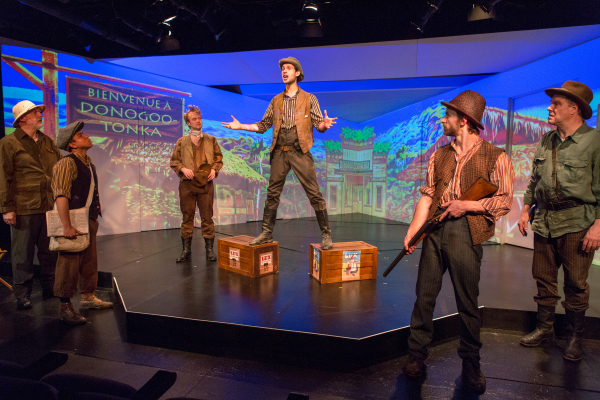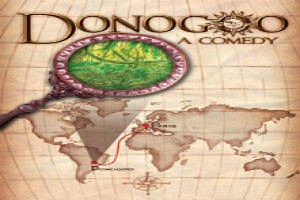Donogoo
The Mint Theater presents lighthearted cynicism in Technicolor with this comedy romp about financial speculation and faulty science.

(© Richard Termine)
Anything is possible with a little bit of magical thinking and a whole lot of cash. French playwright Jules Romains takes this basic truth of Western capitalism to its logical conclusion in his zany comedy Donogoo, which is now receiving a revival at Mint Theater Company. Gus Kaikkonen, who translated and directed Romains' Dr. Knock for Mint in 2010, provides a new translation and direction. Originally produced in 1930, this farce of financial malfeasance and scientific blunder feels shockingly relevant to today's world, in which credit ratings and media hype so often trump solid facts and common sense.
Lamendin (James Riordan) is a man at the end of his rope. The play opens with him standing on the Moselle Bridge in Paris, about to jump. By chance, his friend Benin (Mitch Greenberg) walks by and convinces him to step back from the edge and pay a visit to Dr. Miguel Rufisque (George Morfogen), a biometric psychotherapist who has invented a machine that promises to diagnose Lamendin's ennui and prescribe a cure. Sure enough, once he's strapped into the electric chair-like device, it tells him that he will meet a stranger in front of the mosque of Paris who will change his whole life.
That stranger turns out to be Yves Le Trouhadec (also Morfogen in a performance that is simultaneously subdued and goofy), a disgraced professor of geography who was widely derided for including the fictional village of Donogoo-Tonka in his book on South America. Still, Le Trouhadec wants nothing more than to be elected to the Academy of Sciences. Lamendin sets about making his dream come true by turning Donogoo-Tonka into a reality. Through some shady financial deals, a few well-promoted press events, and a grand expedition to South America, Lamendin aims to create a burgeoning South-American gold-mining community where there was none, essentially proving Le Trouhadec retroactively correct.
Donogoo originated in 1920 as a mock film scenario, a full decade before theatrical technology was able to bring it to the stage. The cinematic flavor remains, with locations never repeating from scene to scene. Kaikkonen achieves this with a smattering of furniture and some of the most complex projections I've ever witnessed. Designers Roger Hanna and Price Johnston have stunningly animated 23 detailed scenes, ranging from brocade-lined Parisian parlors to a neon-colored corner of the Amazon rainforest that might only exist in the mind of Lisa Frank. The actors interact with the projections throughout, magically pulling three-dimensional books out of two-dimensional shelves and walking onto departing trains. Hanna and Johnston have even projected one character's projectile vomit, saving wardrobe and props from untold headaches. These projections are flawlessly executed, allowing the actors to luxuriate in the artifice.
Thirteen actors play a dizzying 52 roles over the course of this madcap play. (Costume designer Sam Fleming richly adorns them all with highly detailed operatic flair.) We're introduced to an unscrupulous French banker (the dryly hilarious Ross Bickell), an Amazon native (the disarmingly shifty-eyed Paul Pontrelli), and several young adventurers in Indiana Jones drag (Brian Thomas Vaughan, Dave Quay, and Scott Thomas). With big characters and even bigger laughs, Donogoo is reminiscent of It's a Mad, Mad, Mad, Mad World. A general hysteria for fast money sets off a frenzied dash for a place that doesn't actually exist. In light of that inconvenient fact, the pioneers of Donogoo decide to create it, using inflated lodging and travel schemes to pray off the dreams and naïveté of those who come later. This is the dark side of If you build it, they will come.
If all this sounds improbable to you, consider that it is no more ridiculous than the 2008 financial crisis, which was largely caused by the implosion of collateralized debt obligations that, while given AAA ratings by agencies like Standard & Poor's and Fitch, were actually worth little more than paper."In America they have a way of resolving problems: They ignore them," says Lamendin, reveling in the success of his new city, founded by what he calls "the triumph of scientific error." Donogoo is an insanely funny caricature of the creation of human delusion. Of course, as we all know, the bursting of that bubble is much less hilarious.









